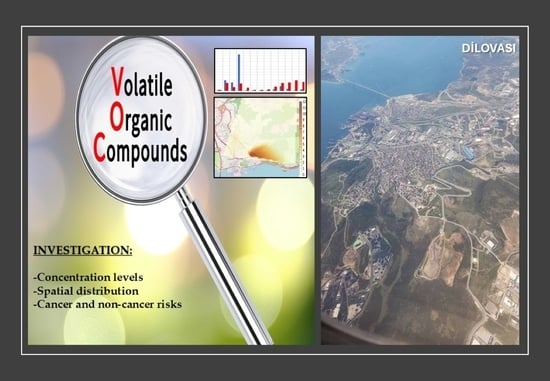Ambient Air VOC Levels in an Industrial Area of Turkey: Levels, Spatial Distribution, and Health Risk Assessment
Abstract
1. Introduction
2. Materials and Methods
2.1. Sampling and Analysis
2.2. Distribution Maps
2.3. Health Risk Assessment
3. Results and Discussion
3.1. Concentration of VOCs in the Ambient Air
3.2. Spatial Analysis of BTEX and Naphthalene
3.3. Health Risk Assessment of VOCs
4. Conclusions
Author Contributions
Funding
Institutional Review Board Statement
Informed Consent Statement
Data Availability Statement
Conflicts of Interest
Abbreviations
| BTEX | Benzene, Toluene, Ethyl Benzene, And Xylene |
| CPF | The Carcinogenic Potency Factor Or Cancer Slope Factor |
| HAPs | Hazardous Air Pollutants |
| HI | Hazard Index |
| HQ | Hazard Quotient |
| IARC | The International Agency for Research on Cancer |
| ILTCR | Integrated Lifetime Cancer Risk |
| LNG | Liquefied Natural Gas |
| NIST | The National Institute of Standards and Technology |
| RAIS | Risk Assessment Information System |
| RfC | Reference Concentration |
| SITARC | Scientific Industrial and Technological Applications and Research Center |
| US EPA | U.S. Environmental Protection Agency |
| VOCs | Volatile Organic Compounds |
References
- Moolla, R.; Curtis, C.J.; Knight, J. Assessment of occupational exposure to BTEX compounds at a bus diesel-refueling bay: A case study in Johannesburg, South Africa. Sci. Total Environ. 2015, 537, 51–57. [Google Scholar] [CrossRef] [PubMed]
- Kim, S.J.; Lee, S.J.; Hong, Y.; Choi, S.D. Investigation of priority anthropogenic VOCs in the large industrial city of Ulsan, South Korea, focusing on their levels, risks, and secondary formation potential. Atmos. Environ. 2025, 343, 120982. [Google Scholar] [CrossRef]
- Guo, Y.; Liu, R.; Li, M.; Li, J.; Wang, X.; Xue, L.; Hou, K. Pollution investigation of wintertime VOCs in the coastal atmosphere of the Yellow Sea: Insights from on-line photoionization-induced CI-TOFMS. Sci. Total Environ. 2024, 957, 177568. [Google Scholar] [CrossRef] [PubMed]
- Shrestha, S.; Yoon, S.; Erickson, M.H.; Guo, F.; Mehra, M.; Bui, A.A.T.; Schulze, B.C.; Kotsakis, A.; Daube, C.; Herndon, S.C.; et al. Traffic, transport, and vegetation drive VOC concentrations in a major urban area in Texas. Sci. Total Environ. 2022, 838, 155861. [Google Scholar] [CrossRef]
- Kumari, S.; Baghel, N.; Lakhani, A.; Kumari, K.M. BTEX and formaldehyde levels at a suburban site of Agra: Temporal variation, ozone formation potential and health risk assessment. Urban Clim. 2021, 40, 100997. [Google Scholar] [CrossRef]
- Masih, A.; Lall, A.S.; Taneja, A.; Singhvi, R. Inhalation exposure and related health risks of BTEX in ambient air at different microenvironments of a terai zone in north India. Atmos. Environ. 2016, 147, 55–66. [Google Scholar] [CrossRef]
- Hazrati, S.; Rostami, R.; Farjaminezhad, M.; Fazlzadeh, M. Preliminary assessment of BTEX concentrations in indoor air of residential buildings and atmospheric ambient air in Ardabil, Iran. Atmos. Environ. 2016, 132, 91–97. [Google Scholar] [CrossRef]
- Beba, H.; Öztürk, Z. Investigation of models predicting NOx level in the sample region and the use of intelligent transportation system. Environ. Chall. 2024, 16, 100990. [Google Scholar] [CrossRef]
- Xiong, Y.; Du, K.; Huang, Y. One-third of global population at cancer risk due to elevated volatile organic compounds levels. npj Clim. Atmos. Sci. 2024, 7, 54. [Google Scholar] [CrossRef]
- García-Garcinuño, R.; Solé-Domènech, L.; Marcé, R.M.; Vallecillos, L.; Borrull, F. Assessment of the presence and risk associated with volatile and semi-volatile organic compounds in urban areas close to petrochemical parks. Chemosphere 2025, 379, 144432. [Google Scholar] [CrossRef]
- Sari, D.; Bayram, A. Quantification of emissions from domestic heating in residential areas of İzmir, Turkey and assessment of the impact on local/regional air-quality. Sci. Total Environ. 2014, 488–489, 429–436. [Google Scholar] [CrossRef] [PubMed]
- Demir, S.; Saral, A.; Išik, D.; Akyildiz, A.; Levent Kuzu, S.; Mert, S.; Goncaloǧlu, B.I.; Demir, G. Characterization of ambient volatile organic compounds and their diurnal variations in Istanbul, Turkey. Fresenius Environ. Bull. 2011, 20, 2951–2958. Available online: https://www.researchgate.net/publication/286316399_Characterization_of_ambient_volatile_organic_compounds_and_their_diurnal_variations_in_Istanbul_Turkey (accessed on 10 March 2025).
- Yurdakul, S.; Çelik, I.; Çelen, M.; Öztürk, F.; Cetin, B. Levels, temporal/spatial variations and sources of PAHs and PCBs in soil of a highly industrialized area. Atmos. Pollut. Res. 2019, 10, 1227–1238. [Google Scholar] [CrossRef]
- Cetin, B.; Yurdakul, S.; Odabasi, M. Spatio-temporal variations of atmospheric and soil polybrominated diphenyl ethers (PBDEs) in highly industrialized region of Dilovasi. Sci. Total Environ. 2019, 646, 1164–1171. [Google Scholar] [CrossRef]
- Cetin, B.; Yurdakul, S.; Gungormus, E.; Ozturk, F.; Sofuoglu, S.C. Source apportionment and carcinogenic risk assessment of passive air sampler-derived PAHs and PCBs in a heavily industrialized region. Sci. Total Environ. 2018, 633, 30–41. [Google Scholar] [CrossRef]
- Yolcubal, I.; Gündüz, Ö.C.; Sönmez, F. Assessment of impact of environmental pollution on groundwater and surface water qualities in a heavily industrialized district of Kocaeli (Dilovası), Turkey. Environ. Earth Sci. 2016, 75, 170. [Google Scholar] [CrossRef]
- Öztürk, N.; Ergenekon, P.; Seçkin, G.Ö.; Bayir, S. Spatial distribution and temporal trends of VOCs in a highly industrialized town in Turkey. Bull. Environ. Contam. Toxicol. 2015, 94, 653–660. [Google Scholar] [CrossRef]
- Bingöl, D.; Ay, Ü.; Karayünlü Bozbaş, S.; Uzgören, N. Chemometric evaluation of the heavy metals distribution in waters from the Dilovasi region in Kocaeli, Turkey. Mar. Pollut. Bull. 2013, 68, 134–139. [Google Scholar] [CrossRef]
- Pekey, B.; Yilmaz, H. The use of passive sampling to monitor spatial trends of volatile organic compounds (VOCs) at an industrial city of Turkey. Microchem. J. 2011, 97, 213–219. [Google Scholar] [CrossRef]
- Özbay, B.; Keskin, G.A.; Doǧruparmak, Ş.Ç.; Ayberk, S. Multivariate methods for ground-level ozone modeling. Atmos. Res. 2011, 102, 57–65. [Google Scholar] [CrossRef]
- Yaylali-Abanuz, G. Heavy metal contamination of surface soil around Gebze industrial area, Turkey. Microchem. J. 2011, 99, 82–92. [Google Scholar] [CrossRef]
- Ergenekon, P.; Öztürk, N.K.; Tavşan, S. Environmental air levels of volatile organic compounds by thermal desorption-gas chromatography in an industrial region envıronmental aır levels of volatıle organıc compounds by thermal desorp-tıon-gas chromatography ın an ındustrıal regıon. Fresenius Environ. Bull. 2009, 18, 1999–2003. Available online: https://www.researchgate.net/publication/289221960 (accessed on 11 May 2025).
- Population, Dilovası Population. Available online: https://www.nufusu.com/ilce/dilovasi_kocaeli-nufusu (accessed on 31 March 2025).
- Google Earth. Available online: https://earth.google.com/ (accessed on 15 January 2024).
- U.S. Environmental Protection Agency, EPA. Compendium Method TO-17, Determination of Volatile Organic Compounds in Ambient Air Using Active Sampling Onto Sorbent Tubes; EPA: Cincinnati, OH, USA, 1999. Available online: https://www.epa.gov/sites/default/files/2019-11/documents/to-17r.pdf (accessed on 20 February 2025).
- Lakestani, S. Volatile organic compounds and cancer risk assessment in an intensive care unit. Int. J. Biometeorol. 2024, 68, 1731–1739. [Google Scholar] [CrossRef] [PubMed]
- U.S. Environmental Protection Agency, EPA. IRIS Agenda. Available online: https://www.epa.gov/iris/iris-agenda (accessed on 20 February 2025).
- Risk Assessment Information System [RAIS]. Toxicity Profile. 2010. Available online: http://rais.ornl.gov (accessed on 20 February 2025).
- US. Environmental Protection Agency. Risk Assessment Guidance for Superfund Volume I Human Health Evaluation Manual (Part F, Supplemental Guidance for Inhalation Risk Assessment); EPA-540-R-070e002; Office of Superfund Remediation and Technology Innovation: Washington, DC, USA, 2009.
- SCHER/SCCP/SCENIHR. Scientific Opinion on the Risk Assessment Methodologies and Approaches for Genotoxic and Carcinogenic Substances, January 2009. Available online: https://ec.europa.eu/health/ph_risk/committees/04_scher/docs/scher_o_113.pdf (accessed on 14 June 2025).
- Health Canada. Cancer Risk Assessment Methodology a Survey of Current Practices at Health Canada; Health Canada: Ottawa, ON, Canada, 2021; Available online: https://www.canada.ca/en/health-canada/services/publications/science-research-data/cancer-risk-assessment-methodology-survey-current-practices.html#a21 (accessed on 14 June 2025)ISBN 978-0-660-40495-0.
- Tunsaringkarn, T.; Siriwong, W.; Rungsiyothin, A.; Nopparatbundit, S. Occupational exposure of gasoline station workers to BTEX compounds in Bangkok, Thailand. Int. J. Occup. Environ. Med. 2012, 3, 117–125. [Google Scholar]
- Ministry of Transport, General Directorate of Highways. Traffic Flow Characteristics and Traffic Parameters of State Roads. Available online: https://www.kgm.gov.tr/SiteCollectionDocuments/KGMdocuments/Yayinlar/YayinPdf/Devlet%20Yollar%C4%B1%20Trafik%20Ak%C4%B1m%C4%B1%20%C3%96zellikleri%20ve%20Trafik%20Parametreleri.pdf (accessed on 10 March 2025).
- Yılmaz, M.; Toros, H.; İncecik, S.; Öztürk, Z.; Kirkil, G.; Öztaş, D.; Akçay, M.; Dinç, U.; Gültekin, M.; Emanet Beba, H.; et al. Evaluation of dilovası air pollution in terms of traffic emissions. Natl. J. Environ. Sci. Res. 2020, 3, 43–51. Available online: https://dergipark.org.tr/tr/pub/ucbad/issue/54360/738990 (accessed on 15 April 2025.).
- Mullaugh, K.M.; Hamilton, J.M.; Avery, G.B.; Felix, J.D.; Mead, R.N.; Willey, J.D.; Kieber, R.J. Temporal and spatial variability of trace volatile organic compounds in rainwater. Chemosphere 2015, 134, 203–209. [Google Scholar] [CrossRef]
- Meteoblue. Simulated Historical Climate and Weather Data for Dilovasi. Available online: https://www.meteoblue.com/tr/hava/historyclimate/climatemodelled/dilovasi_t%C3%BCrkiye-cumhuriyeti_9965495?utm_source (accessed on 14 June 2025).
- Mağat Türk, E. Spatial Monitoring of Gaseous Pollutants in the City Center of Bolu by Passive Sampling Method. Master’s Thesis, Department Of Chemistry, the Graduate School of Natural and Applied Sciences, Bolu Abant Izzet Baysal University, Bolu, Türkiye, 2019. [Google Scholar]
- Hosseini, S.A.; Abtahi, M.; Dobaradaran, S.; Hassankhani, H.; Koolivand, A.; Saeedi, R. Assessment of health risk and burden of disease induced by exposure to benzene, toluene, ethylbenzene, and xylene in the outdoor air in Tehran, Iran. Environ. Sci. Pollut. Res. 2023, 30, 75989–76001. [Google Scholar] [CrossRef]
- Khoshakhlagh, A.S.; Yazdanirad, S.; Mousavi, M.; Gruszecka-Kosowska, A.; Shahriyari, M.; Rajabi-Vardanjani, H. Summer and winter variations of BTEX concentrations in an oil refinery complex and health risk assessment based on Monte-Carlo simulations. Sci. Rep. 2023, 13, 10670. [Google Scholar] [CrossRef]
- Mandal, T.K.; Yadav, P.; Kumar, M.; Lal, S.; Soni, K.; Yadav, L.; Saharan, U.S.; Sharma, S.K. Characteristics of volatile organic compounds (VOCs) at an urban site of Delhi, India: Diurnal and seasonal variation, sources apportionment. Urban Clim. 2023, 49, 101545. [Google Scholar] [CrossRef]
- Raysoni, A.U.; Pinakana, S.D.; Luna, A.; Mendez, E.; Ibarra-Mejia, G. Characterization of BTEX species at Texas Commission on Environmental Quality (TCEQ) Continuous Ambient Monitoring Station (CAMS) sites in Houston, Texas, USA during 2018. Sustain. Chem. Environ. 2025, 9, 100227. [Google Scholar] [CrossRef]
- Bauri, N.; Bauri, P.; Kumar, K.; Jain, V.K. Evaluation of seasonal variations in abundance of BTXE hydrocarbons and their ozone forming potential in ambient urban atmosphere of Dehradun (India). Air Qual. Atmos. Health 2016, 9, 95–106. [Google Scholar] [CrossRef]
- Turkish Statistical Institute. Distribution of Registered Cars According to Fuel Type. Available online: https://data.tuik.gov.tr/Bulten/Index?p=Motorlu-Kara-Tasitlari-Nisan-2024-53456#:~:text=Nisan%20ay%C4%B1%20sonu%20itibar%C4%B1yla%20trafi%C4%9Fe%20kay%C4%B1tl%C4%B1%2015%20milyon%20562%20bin,%250%2C2 (accessed on 20 February 2025).
- Singh, R.; Gaur, M.; Shukla, A. Seasonal and Spatial Variation of BTEX in Ambient Air of Delhi. J. Environ. Prot. 2016, 07, 670–688. [Google Scholar] [CrossRef]
- Srivastavaa, A.; Josepha, A.E.; Devottab, S. Volatile organic compounds in ambient air of Mumbai—India. Atmos. Environ. 2006, 40, 892–903. [Google Scholar] [CrossRef]
- Pekey, H.; Pekey, B.; Arslanbas, D.; Bozkurt, Z.; Dogan, G.; Tuncel, G. Source identification of volatile organic compounds and particulate matters in an urban and industrial areas of Turkey. Ekoloji 2015, 24, 1–9. [Google Scholar] [CrossRef]
- Ghosh, B.; De, M.; Rout, T.K.; Padhy, P.K. Study on spatiotemporal distribution and health risk assessment of BTEX in urban ambient air of Kolkata and Howrah, West Bengal, India: Evaluation of carcinogenic, non-carcinogenic and additional leukaemia cases. Atmos. Pollut. Res. 2023, 14, 101878. [Google Scholar] [CrossRef]
- Tsai, J.H.; Lu, Y.T.; Chung, I.I.; Chiang, H.L. Traffic-related airborne VOC profiles variation on road sites and residential area within a microscale in urban area in Southern Taiwan. Atmosphere 2020, 11, 1015. [Google Scholar] [CrossRef]
- Le, T.H.; Lin, C.; Nguyen, D.H.; Cheruiyot, N.K.; Yuan, C.S.; Hung, C.H. Volatile organic compounds in ambient air of a major Asian port: Spatiotemporal variation and source apportionment. Environ. Sci. Pollut. Res. 2023, 30, 28718–28729. [Google Scholar] [CrossRef]
- Legislation Information System of the Republic of Turkey. National Air Quality Assessment and Management Regulation, Date 09/09/13 and Number 31677. Available online: https://www.mevzuat.gov.tr/mevzuat?MevzuatNo=12188&MevzuatTur=7&MevzuatTertip=5 (accessed on 20 April 2025.).
- Buckpitt, A.; Kephalopoulos, S.; Koistinen, K.; Kotzias, D.; Morawska, L.; Sagunski, H. Naphthalene. In WHO Guidelines for Indoor Air Quality: Selected Pollutants; World Health Organization: Geneva, Switzerland, 2010. Available online: https://www.ncbi.nlm.nih.gov/books/NBK138704/ (accessed on 1 May 2025).
- Kamal, A.; Qayyum, M.; Cheema, I.U.; Rashid, A. Biological Monitoring of Blood Naphthalene Levels as a Marker of Occupational Exposure to PAHs among Auto-Mechanics and Spray Painters in Rawalpindi. BMC Public Health 2011, 11, 467. [Google Scholar] [CrossRef]
- Wang, M.; Li, S.; Zhu, R.; Zhang, R.; Zu, L.; Wang, Y.; Bao, X. On-road tailpipe emission characteristics and ozone formation potentials of VOCs from gasoline, diesel and liquefied petroleum gas fueled vehicles. Atmos. Environ. 2020, 223, 117294. [Google Scholar] [CrossRef]
- Yost, E.E.; Galizia, A.; Kapraun, D.F.; Persad, A.S.; Vulimiri, S.V.; Angrish, M.; Lee, J.S.; Druwe, I.L. Health effects of naphthalene exposure: A systematic evidence map and analysis of potential considerations for dose–response evaluation. Environ. Int. 2021, 150, 106438. [Google Scholar] [CrossRef]
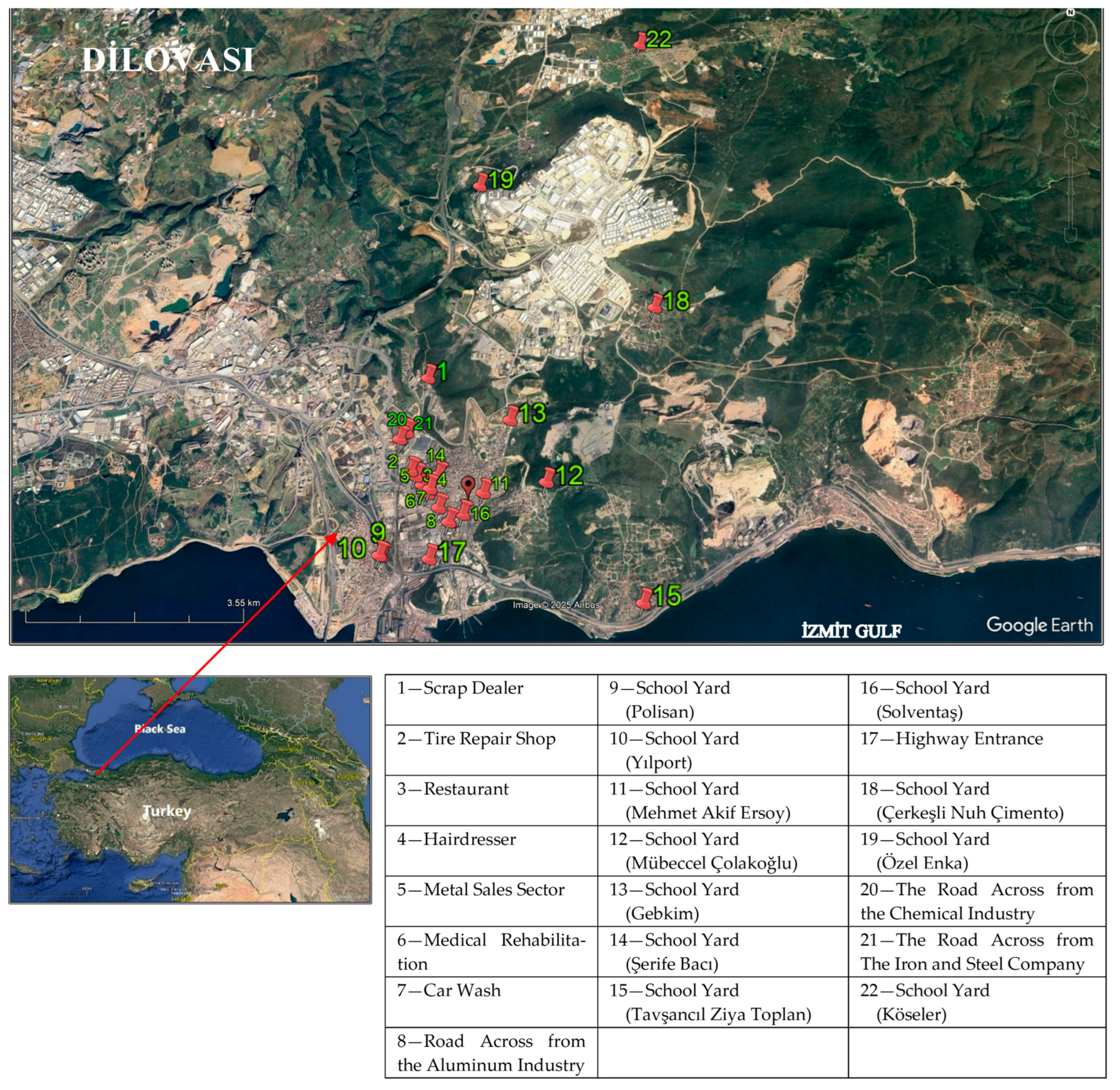
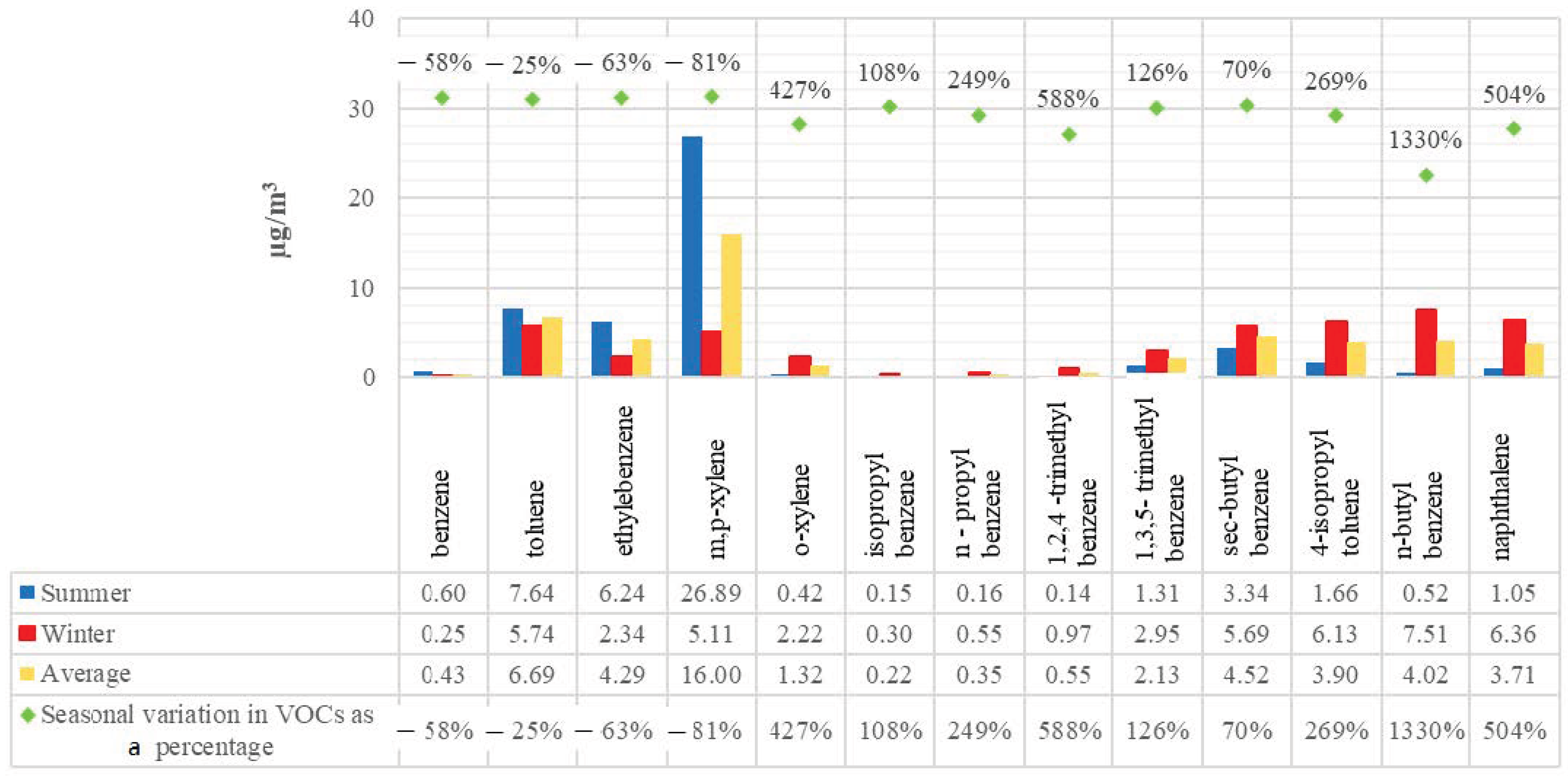
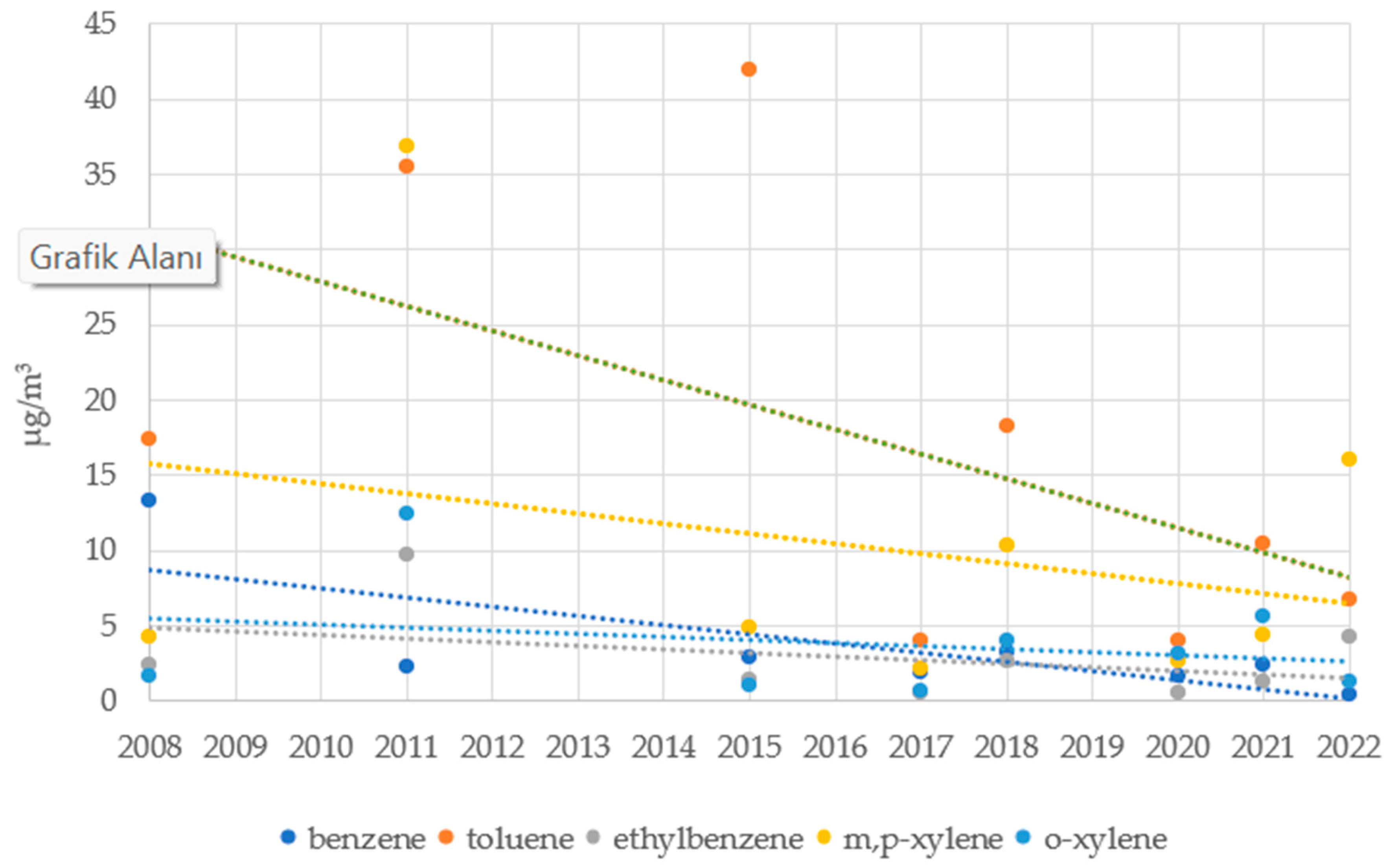
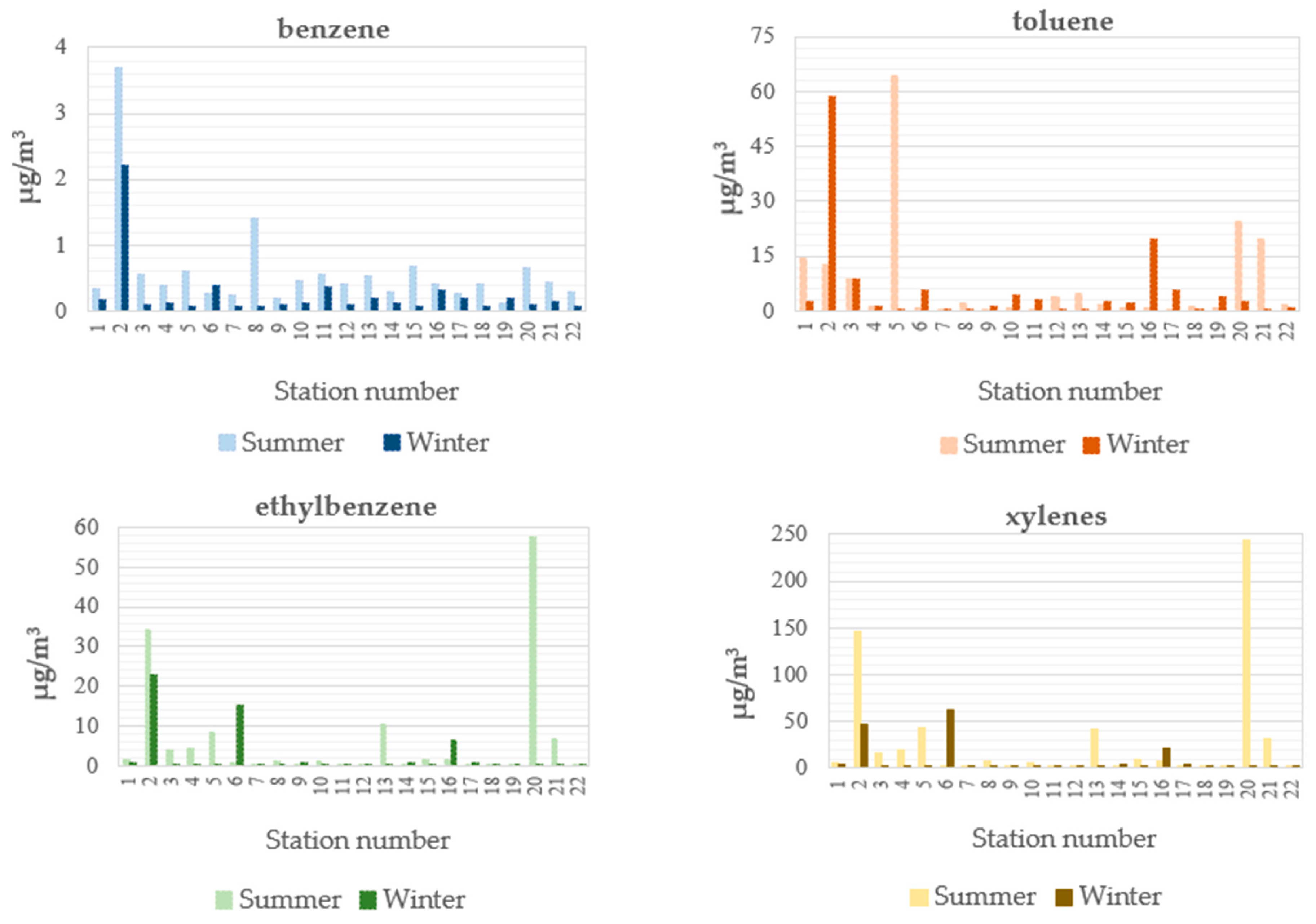
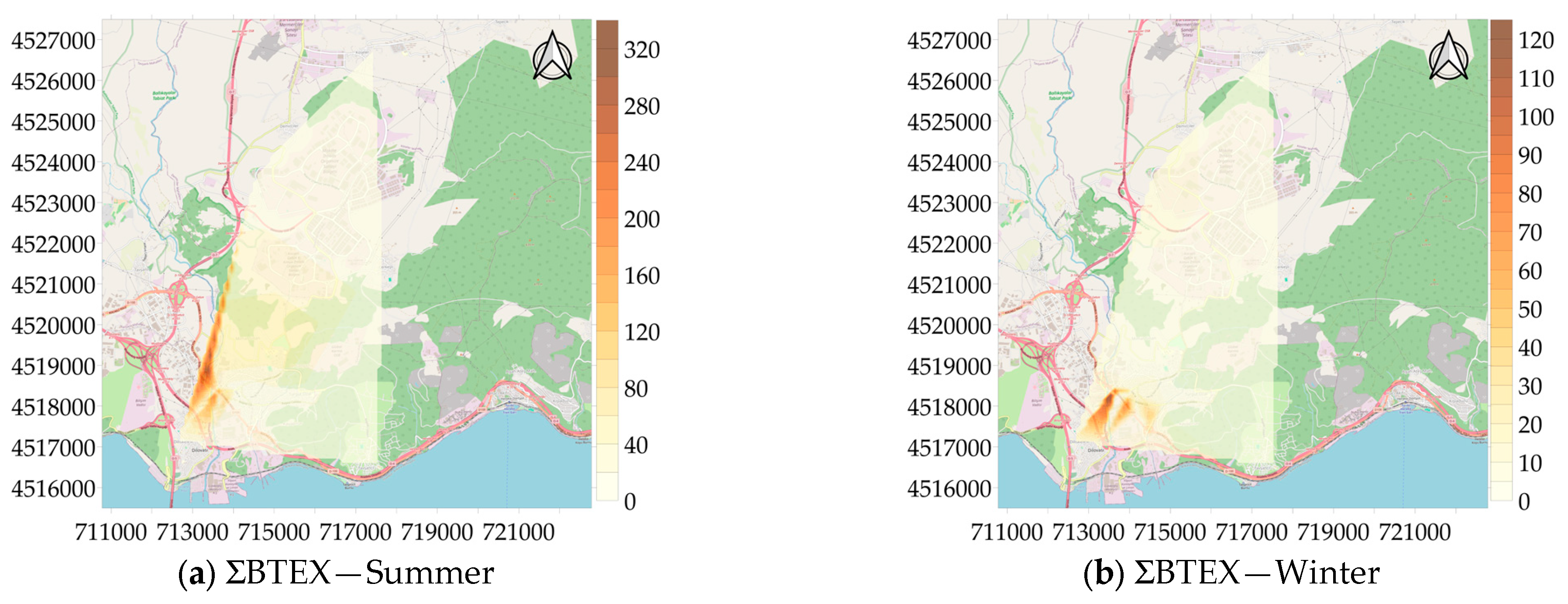
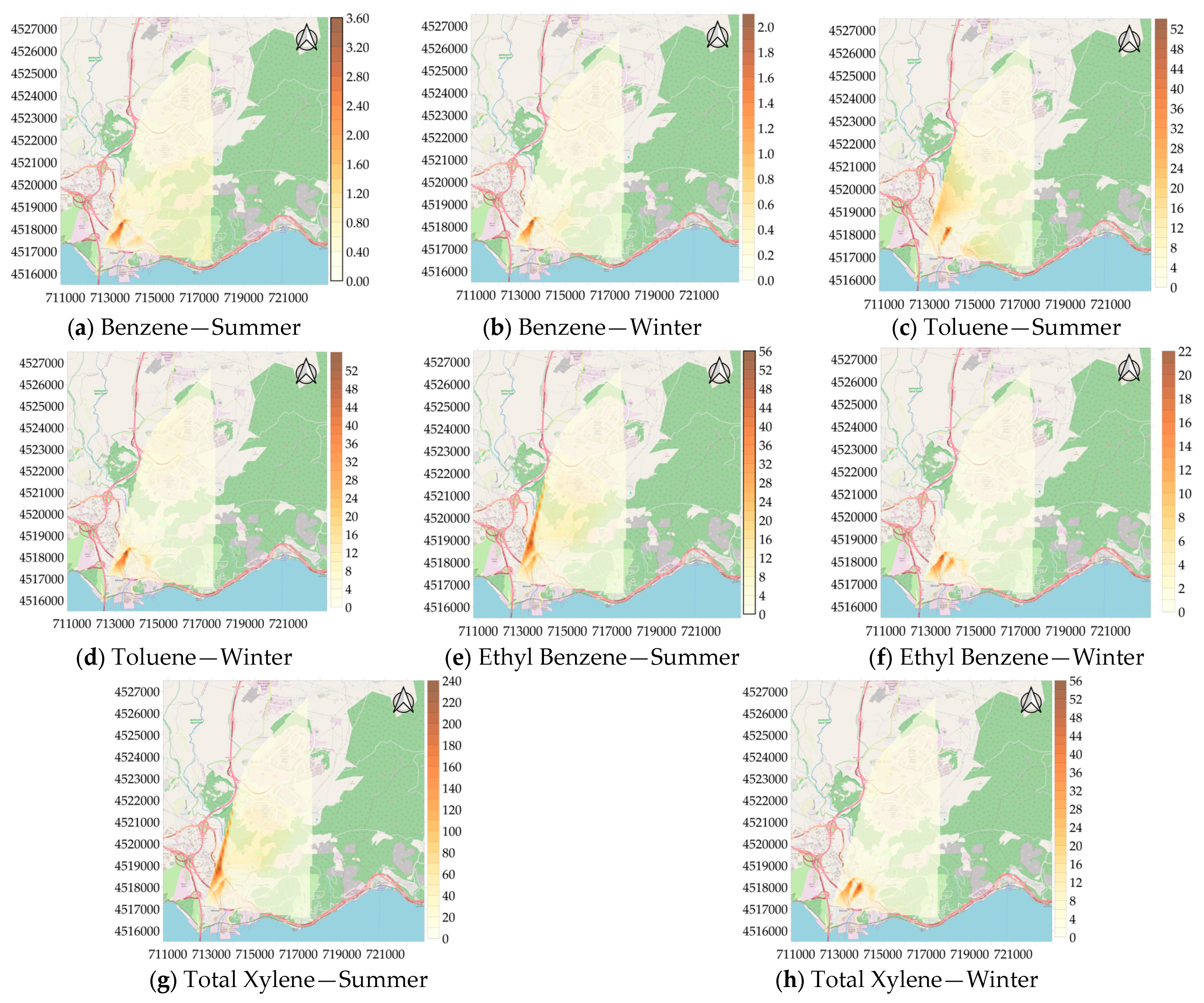
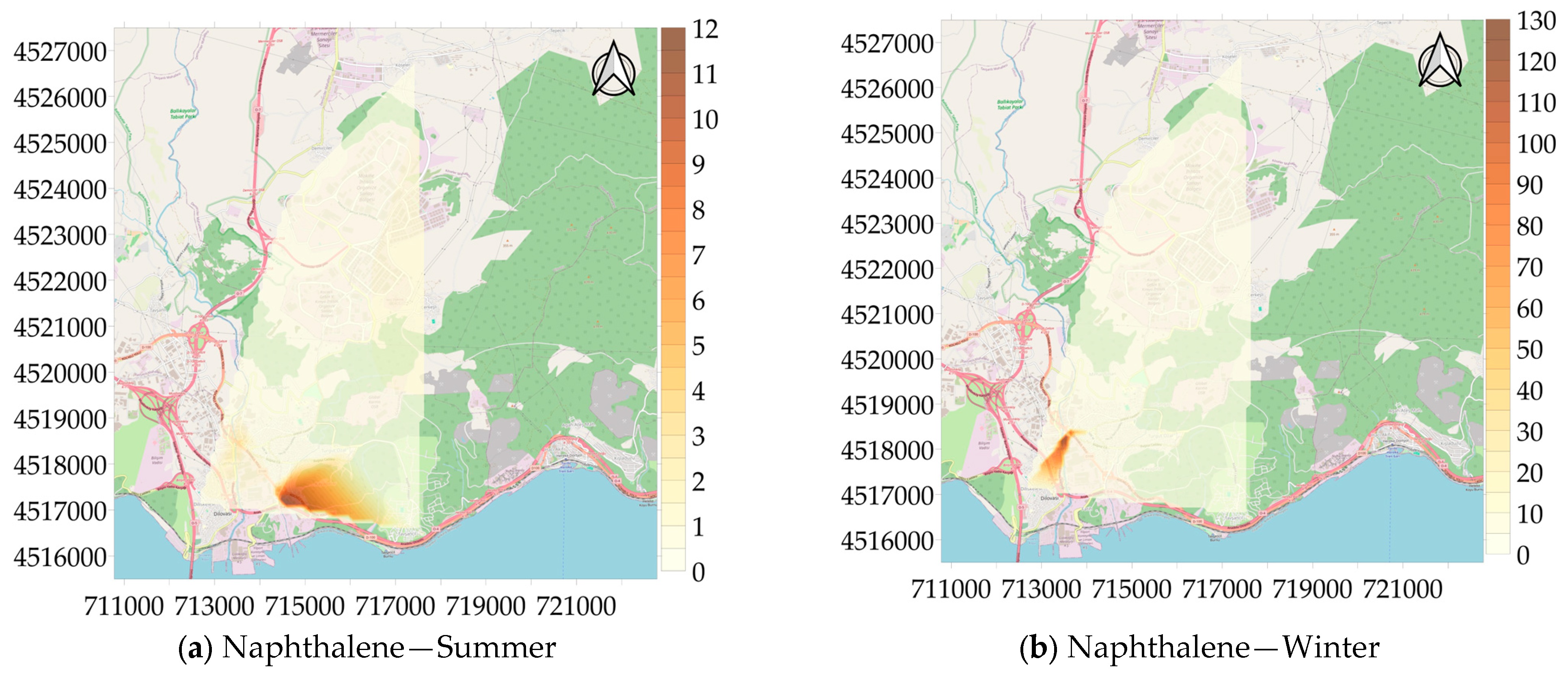

| Compound | CPF (1/(mg/kg/day)) | RfC (mg/m3) |
|---|---|---|
| benzene | 2.73 × 10−2 | 0.03 |
| toluene | NA | 5 |
| ethylbenzene | 3.85 × 10−3 | 1 |
| m,p-xylene | NA | 0.1 |
| o-xylene | NA | 0.1 |
| isopropylbenzene | NA | 0.4 |
| n-propylbenzene | NA | NA |
| 1,2,4-trimethylbenzene | NA | 0.2 |
| 1,3,5-trimethylbenzene | NA | 0.2 |
| sec-butylbenzene | NA | NA |
| 4-isopropyl-toluene | NA | NA |
| n-butylbenzene | NA | NA |
| naphthalene | 1.19 × 10−1 | 0.003 |
| Exposure Parameters | ||
| IR (inhalation rate for adults) | 0.83 m3/h | |
| ED (exposure duration for adults) | 24 h/day | |
| BW (body weight for adult) | 70 kg | |
| D (days per week exposure) | 7 days | |
| WK (weeks of exposure) | 52 weeks | |
| YE (years of exposure for adults) | 15 years | |
| YL (years in lifetime for adults) | 75 years | |
| Station Number | Average | |||
|---|---|---|---|---|
| T/B | X/E | B/T | X/B | |
| 1 | 33.15 | 4.62 | 0.03 | 20.48 |
| 2 | 12.04 | 3.37 | 0.08 | 32.53 |
| 3 | 26.31 | 3.96 | 0.04 | 26.12 |
| 4 | 5.68 | 4.30 | 0.18 | 39.51 |
| 5 | 94.93 | 5.23 | 0.01 | 65.16 |
| 6 | 9.82 | 4.05 | 0.10 | 96.17 |
| 7 | 3.14 | 4.40 | 0.32 | 8.19 |
| 8 | 1.52 | 5.83 | 0.66 | 5.63 |
| 9 | 6.13 | 5.75 | 0.16 | 20.23 |
| 10 | 8.70 | 4.52 | 0.11 | 12.12 |
| 11 | 3.81 | 5.45 | 0.26 | 3.85 |
| 12 | 8.70 | 5.30 | 0.11 | 6.02 |
| 13 | 7.56 | 4.12 | 0.13 | 60.63 |
| 14 | 10.84 | 4.78 | 0.09 | 12.60 |
| 15 | 3.96 | 5.75 | 0.25 | 12.81 |
| 16 | 27.60 | 3.49 | 0.04 | 38.04 |
| 17 | 12.80 | 4.66 | 0.08 | 13.80 |
| 18 | 3.80 | 4.77 | 0.26 | 6.18 |
| 19 | 13.54 | 5.25 | 0.07 | 13.03 |
| 20 | 34.37 | 4.25 | 0.03 | 314.85 |
| 21 | 33.68 | 4.55 | 0.03 | 53.52 |
| 22 | 7.54 | 5.32 | 0.13 | 10.29 |
Disclaimer/Publisher’s Note: The statements, opinions and data contained in all publications are solely those of the individual author(s) and contributor(s) and not of MDPI and/or the editor(s). MDPI and/or the editor(s) disclaim responsibility for any injury to people or property resulting from any ideas, methods, instructions or products referred to in the content. |
© 2025 by the authors. Licensee MDPI, Basel, Switzerland. This article is an open access article distributed under the terms and conditions of the Creative Commons Attribution (CC BY) license (https://creativecommons.org/licenses/by/4.0/).
Share and Cite
Karademir, A.; Arpaz, E.; Çetin Doğruparmak, Ş.; Özgül, G. Ambient Air VOC Levels in an Industrial Area of Turkey: Levels, Spatial Distribution, and Health Risk Assessment. Toxics 2025, 13, 540. https://doi.org/10.3390/toxics13070540
Karademir A, Arpaz E, Çetin Doğruparmak Ş, Özgül G. Ambient Air VOC Levels in an Industrial Area of Turkey: Levels, Spatial Distribution, and Health Risk Assessment. Toxics. 2025; 13(7):540. https://doi.org/10.3390/toxics13070540
Chicago/Turabian StyleKarademir, Aykan, Ercan Arpaz, Şenay Çetin Doğruparmak, and Gülsün Özgül. 2025. "Ambient Air VOC Levels in an Industrial Area of Turkey: Levels, Spatial Distribution, and Health Risk Assessment" Toxics 13, no. 7: 540. https://doi.org/10.3390/toxics13070540
APA StyleKarademir, A., Arpaz, E., Çetin Doğruparmak, Ş., & Özgül, G. (2025). Ambient Air VOC Levels in an Industrial Area of Turkey: Levels, Spatial Distribution, and Health Risk Assessment. Toxics, 13(7), 540. https://doi.org/10.3390/toxics13070540






